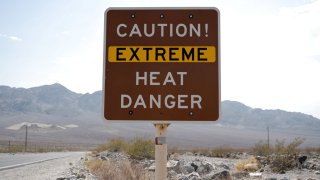
A sign warns of extreme heat in Death Valley, California, U.S., July 11, 2021.
Death Valley National Park's Furnace Creek experienced a 17-day heat wave with temperatures reaching 120-to-128 degrees Fahrenheit. According to park officials, the heat wave is the longest streak of temperatures in 94-years and tied for the third longest heat wave in park history.
“The only way to describe it for people who have not experienced, would be opening up your oven and sticking your head inside, that’s what it feels like,” said park spokesperson Abby Wines.
Death Valley is the largest National Park in the contiguous U.S. at 3.5 million acres. The hottest recorded day in the park's history was on July 10, 1913, when the temperature reached 134 degrees Fahrenheit.
In the last 10 years, 7 of the 10 hottest summers have happened at the national park with this July being the second hottest on record with an average temperature of 107.6 degrees.
Get Southern California news, weather forecasts and entertainment stories to your inbox. Sign up for NBC LA newsletters.
Despite the excessive heat warnings, tourists continue to visit the park in great numbers. Wines says some of their visitors will often arrive not really knowing about the extreme heat conditions that await them.
“The most important thing is to avoid the heat, that’s better than anything that I can say about wearing a hat or sunscreen or drinking water or salty snacks. Those are all helpful, but the main thing is to avoid the heat,” said Wines.
The high temperatures not only pose a risk to tourists but have a great impact on the plants and animals that inhabit the desert valley.
Local
Get Los Angeles's latest local news on crime, entertainment, weather, schools, COVID, cost of living and more. Here's your go-to source for today's LA news.
Representatives of the national park say that some wildlife are living on the edge of survival and temperature increase can pose a threat to their livelihoods.
Species of trees like the Great Basin bristlecone pines have suffered huge losses in their populations over the last decade. The trees were originally thought to be resistant to bark beetle attacks but according to Death Valley officials, droughts and warmer winters have made them more vulnerable.
Park officials say for those planning to visit Death Valley this summer, come prepared for extreme heat conditions. It is strongly advised that all hiking gets done before 10 a.m. and to try to avoid the lower elevation trails or it can get dangerous.